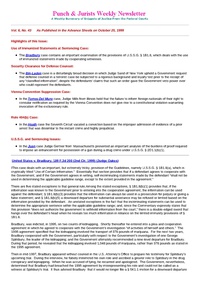Here the district court had previously ruled that the petitioner was entitled to a hearing on several issues, including a prosecutor’s possible misconduct during a 1994 murder trial in failing to reveal his knowledge that there was reason to suspect a juror of bias. Before that hearing could take place, …
Both defendants, Jones and Yazzie, appeals their convictions for second degree murder and aiding and abetting second degree murder. The Court of Appeals consolidated the two cases and reversed and remanded both cases for a new trial because the jury was not given an instruction for the lesser-included offense of …
The Court stated: "The issue certified for a ppeal effectively asks: When a habeas petitioner has sought direct review of a judgment of conviction in the highest state court, but thereafter does not file a petition for a writ of certiorari from the United States Supreme Court, does the AEDPA's …
For a contray view, see U.S. v. Zwick, No. 98-3641 (3rd Cir. 12/15/99); and U.S. v. Santopietro, 166 F.3d 88 (2nd Cir. 1999).
Here the Court held that the district court did not err in concluding that 18 U.S.C. § 666 does not require a nexus between the alleged bribes …
In this case, the defendant was first represented by court-appointed counsel. On the eve of trial, another lawyer appeared and announced that he would be representing the defendant. Neither the judge, the prosecutor, nor the defendant knew that the leader of the alleged drug conspiracy was paying his law firm. …
Here the Court held that the district court erred by relying on immunized statements made pursuant to USSG § 1B1.8, even though the Government alleged the defendant had breached his earlier plea agreement and then signed a new agreement.
This case deals with an important, but extremely tricky, provision of …
Following an earlier remand, the Court concluded that the district court did not err in imposing an "official victim" enhancement under USSG § 3A1.2(a) where it found that a policeman was a victim and did not rely on impermissible relevant conduct.
The defendant in this case was charged with unlawfully …
Here the Court held that the admission of evidence about a prior crime was improper under Fed.R.Evid. Rule 404(b), both because the prior crime was not similar to the instant charge, and because its admission was “extremely prejudicial”.
This case is noted as a rare example in which a court …
In this case, the defendant was originally sentenced to a 57 month term of imprisonment and three years of supervised release after pleading guilty to arson of a dwelling on an Indian reservation. He served his prison term and began his term of supervised release. It was revoked, and he …
This case is noted as a rare example in which a court held that the admission of evidence about a prior crime was improper under Fed.R.Evid. Rule 404(b), both because the prior crime was not similar to the instant charge, and because its admission was “extremely prejudicial.”
In this case …
Earlier this year a panel from the Ninth Circuit set off a stir when it held, in U.S. v. Lombera-Camorlinga, 170 F.3d 1241 (9th Cir. 1999), that statements made to the authorities may be suppressed, and criminal convictions overturned, if foreign nationals arrested in the United States are not advised …
Here, the defendant relied primarily on U.S. v. Sloley, 19 F.3d 149, 154 (4th Cir. 1994), where that Court stated that "[i]f both § 3A1.2(b) and § 3C1.2 apply to a defendant, the court must apply only the former and increase the offense level by three levels." The Eleventh Circuit …
Here the Court vacated a conviction because the Government failed to provide reasonable notice in advance of trial that it intended to use "other crimes" evidence, after the defendant specifically requested such information.
The defendant was convicted of the importation and possession of marijuana and aiding and abetting in violation …
In this case the court addressed the constitutionality of a policy issued by the Maricopa County Sheriff prohibiting inmates from possessing “sexually explicit” material. Mauro, an inmate in the County jail filed an action under 42 U.S.C.S. § 1983 claiming that the policy infringed on his First Amendment rights. The …
This decision portends a disturbing new approach by the Government in its ongoing efforts to withhold discovery materials from the defense and to seek a veto over a defendant’s choice of counsel. In this case the Government was prosecuting fifteen defendants for numerous crimes arising principally from the bombing of …
This is a significant decision that deals with the history, purposes and interpretation of U.S.S.G. § 2D1.1(b)(1), a provision that establishes a two-level sentencing enhancement if a dangerous weapon was “possessed” in connection with a drug crime. Actually, the language does not specify whether the gun must be possessed “in …
